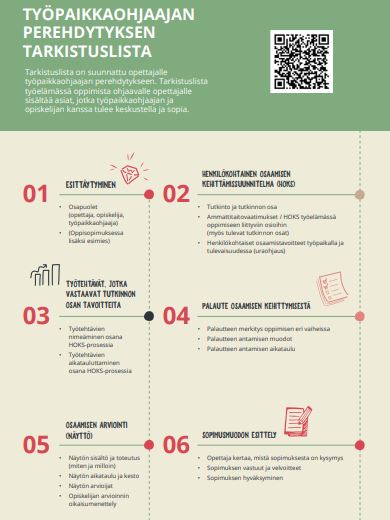Students acquire skills in different learning environments. Training that takes place in the workplace and consists of practical tasks is called work-based learning. Employing a student provides an opportunity to get new workforce.
Vocational education and training always involves work-based learning.
The following are always determined in advance before a work-based learning period:
- main work tasks
- goals
- instruction
- the assessment schedule
The above are agreed with the responsible teacher (= the PCDP instructor) when the training or apprenticeship agreement is compiled and signed. The PCDP instructor is always there to support the student and the employer if necessary. More information about the agreements you can find here.
An important goal of work-based learning is to learn professional skills in practice and to gain work experience. Work-based learning is particularly important for young students or those entering a new field who have not yet gained work experience in the field.
Each student is assigned a workplace instructor and assessor, who may be the same person. There may also be more than one assessor. The workplace instructor can assign supervising responsibility to other people if necessary. The PCDP instructor of the student acts as the contact person for the student and the workplace in Business College. Each student has a personal competence development plan (PCDP), which contains the content of the qualification.
The workplace instructor must have professional skill in the fields in which he/she acts as an instructor. The workplace instructor needs interpersonal and guidance skills and a willingness to share his/her expertise. Patience and a sense of humour are useful in tutoring situations. Tutoring takes time, but it also develops the tutoring and leadership skills of the workplace instructor.
On this website, you will find more information in English on training agreements and apprenticeship training agreements.
A successful work-based learning period
Work-based learning is a good opportunity for the employer to get new employees. During the work-based learning period, the employer has the chance to get to know the student and the possibility to hire a longer-term employee. The student also often brings along new, fresh insights and ideas.
Orientation is particularly important for students entering working life for the first time. An effective orientation will help students to become productive employees more quickly. The orientation should cover at least the following:
- the physical workplace
- duties (job orientation)
- the work community and its customs (ground rules)
- safety guidelines
The need for guidance is greatest at the beginning of the work-based learning period. A thorough description of duties and a transfer tacit knowledge are the best things a workplace instructor can give the student.

A checklist for a successful work-based learning period
- Goals are defined and scheduled.
- Working hours and ground rules are agreed.
- Work tasks are as varied as possible and appropriately challenging.
- The workplace instructor has time for guidance.
- Mutual feedback is given.
- Experiences and views are discussed.
- The working community is involved in providing guidance and support.
- The work atmosphere is safe and good.
